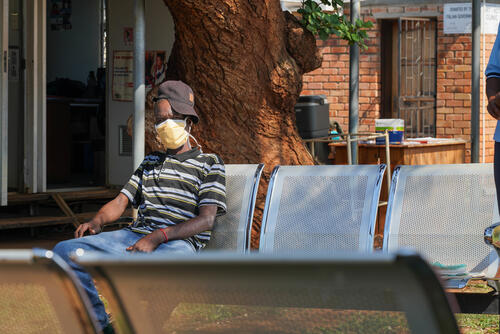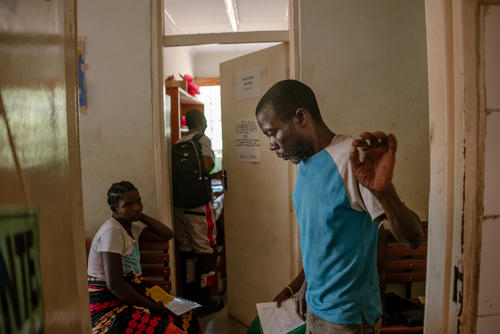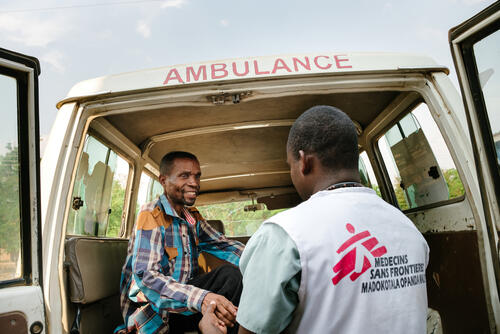- A high number of people living with HIV continue to die and the yearly number of AIDS-related deaths is stagnating
- Lack of access to diagnosis and treatment for opportunistic infections such as TB is driving the high number of deaths
- Governments, ministries of health, international agencies and donors must increase funding and efforts to reduce the number of HIV/AIDS deaths
Brussels/Geneva/Johannesburg - Nearly 770,000 people died of HIV worldwide in 2018. These are disturbing figures in the UNAIDS Global Aids Update 2019 released in Eshowe, South Africa. Timely use of effective diagnostic tools and medicines to treat HIV/AIDS could prevent most deaths, and yet the annual number of deaths due to AIDS has declined only minimally since 2014, a cause for concern for Médecins Sans Frontières.
While 2 million more people received antiretroviral therapy (ART) in 2018 compared to the year before, more needs to be done to confront the killer infections driving AIDS deaths, starting with tuberculosis (TB) and cryptococcal meningitis.
Preventing, detecting and treating advanced HIV and AIDS demands more attention and funding, especially in low coverage settings such as West and Central Africa, and in neglected populations.Dr Gilles Van Cutsem, MSF HIV Working Group Leader
The decline in deaths for HIV/AIDS is stagnating
770,000
770,
800,000
800,
840,000
840,
Delayed diagnosis and treatment leads to deaths
“In MSF-supported hospitals in the Democratic Republic of Congo, Guinea, Malawi and elsewhere, many deaths occur within 48 hours of people being admitted to hospital,” explains Dr Gilles Van Cutsem, leader of MSF’s HIV/AIDS Working Group. “People arrive very ill, often with severe opportunistic infections such as tuberculosis, cryptococcal meningitis, or Kaposi's sarcoma. When they arrive, sometimes it's too late to save them. They might not have been diagnosed on time or they failed to get access to a lifesaving treatment.”
AIDS-related deaths are primarily driven by delayed diagnosis, treatment interruptions and virologic and immunologic failure among HIV treatment-experienced people.
The World Health Organization (WHO) estimates that more than 30 per cent of people who start HIV treatment worldwide have advanced disease with severe immune suppression, which puts them at a very high risk of contracting opportunistic infections and dying.
If primary care clinics are not equipped and trained to detect advanced HIV, people at risk will remain undetected and untreated; they will deteriorate until they are terminally ill.Dr Gilles Van Cutsem, MSF HIV Working Group Leader
TB, cryptococcal meningitis key opportunistic infections
One in three deaths linked to AIDS worldwide is due to TB. Cryptococcal meningitis (an infection of the brain) affects hundreds of thousands of people living with HIV each year and accounts for 15 to 20 per cent of all AIDS-related deaths.
Other serious opportunistic infections contribute to AIDS-related mortality, although they can be cured, such as pneumocystis, bacterial pneumonia, and sepsis. However, very little attention has been paid to the detection and management of people living with advanced HIV, and access to diagnostic tests and treatment for many opportunistic infections is severely limited.
Lack of access to diagnosis and proper treatment for opportunistic infections
In countries where MSF works, diagnostic tools such as the CD4 cell count, which is needed to diagnose advanced HIV disease, are often missing. Tests which provide quick diagnosis of tuberculosis and cryptococcal meningitis, TB-Lam and CrAg LFA, also remain unavailable, particularly in primary healthcare centres where most people go for their healthcare needs.
“Many people go first to primary healthcare centres when they feel sick,” explains Dr Van Cutsem. “If primary care clinics are not equipped and trained to detect advanced HIV, people at risk will remain undetected and untreated; they will deteriorate until they are terminally ill. Then some will be referred to hospitals often missing the basic tools to manage them.’’
People arrive very ill, often with severe opportunistic infections such as tuberculosis… when they arrive, sometimes it's too late to save them.Dr Gilles Van Cutsem, MSF HIV Working Group Leader
Targets to reduce deaths likely to be missed
In 2016, UN member states endorsed the goal of cutting deaths from HIV/AIDS by 50 per cent by 2020, to less than 500,000 per year. Six months before this deadline, countries are far from achieving this target. AIDS-related deaths have reduced by only 30,000 in 12 months, down to 770,000 in 2018; this compares to 800,000 people dying in 2017 and 840,000 deaths in 2016. With these figures, mortality reduction is stagnating.
UN member states also agreed to UNAIDS’s 90-90-90 targets where 90 per cent of people living with HIV know their status, 90 per cent of HIV positive people are on antiretroviral treatment, and 90 per cent of people on treatment have an undetectable viral load.
Earlier this year, MSF and the South African Department of Health demonstrated that it is possible to achieve the 90-90-90 targets and a possible reduction of HIV incidence in Eshowe, KwaZulu Natal province in South Africa, with intensive community-based services linked to primary care facilities supported by training, mentoring and monitoring.
While encouraging, Eshowe remains an exception and few other districts, provinces or countries will reach the 90-90-90 targets in 2020. In many countries, antiretroviral treatment coverage remains too low to impact mortality and illness. In particular, countries in the West and Central Africa region need to increase the number of people on treatment but are facing a shortfall in international funding, including for antiretroviral treatment scale-up. These countries and communities must urgently get the necessary resources and support to apply the community approaches of HIV testing and treatment, like in Eshowe.
Governments, ministries of health, international agencies, donors and partner organisations must step up efforts and focus to reduce the mortality of people living with HIV, with specific enhanced attention towards preventing, detecting and treating advanced HIV and AIDS.
“We cannot celebrate or talk of success while hundreds of thousands of people continue to die of AIDS every year, because they can not access basic HIV care, either because they live in countries that are neglected, because they are part of neglected population groups, or because of policies that choose to ignore them,” said Dr Van Cutsem. “Preventing, detecting and treating advanced HIV and AIDS demands more attention and funding, especially in low coverage settings such as West and Central Africa, and in neglected populations.”






